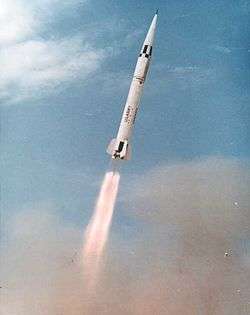MGM-29 Sergeant
| MGM-29 Sergeant | |
|---|---|
 Launch of a MGM-29 | |
| Type | Tactical ballistic missile |
| Place of origin | United States |
| Service history | |
| In service | 1962–1979 |
| Used by |
United States Army German Army |
| Production history | |
| Designer | Jet Propulsion Laboratory |
| Designed | 1955 |
| Manufacturer | Sperry Utah |
| No. built | ~500 |
| Specifications | |
| Weight | 10,100 lb (4,600 kg) |
| Length | 34 ft 6 in (10.52 m) |
| Diameter | 31 in (79 cm) |
|
| |
| Warhead | W52 (M65) nuclear |
| Blast yield | 200 kt |
|
| |
| Engine |
Thiokol XM100 200 kN (45,000 lbf) |
| Propellant | Solid fuel |
Operational range | 75 nmi (139 km) |
| Boost time | 34 sec |
Guidance system | Inertial |
The MGM-29 Sergeant was an American short-range, solid fuel, surface-to-surface missile developed at the Jet Propulsion Laboratory. The missiles were built by Sperry Utah Company. The Sergeant was the fourth and last in a series of JPL rockets for the US Army whose names correspond to the progression in Army enlisted ranks, starting with Recruit, Private and Corporal.
Activated by the US Army in 1962 to replace the MGM-5 Corporal, it was deployed in Europe and South Korea by 1963, carrying the W52 (M65) nuclear warhead or alternatively one of high explosives. A biological warhead, the M210, was standardized but not procured, and there was also a chemical variant, the M212 which had not attained standardization. It was replaced by the MGM-52 Lance and the last US Army battalion was deactivated in 1977. Sergeant Missile Systems were usually assigned to the field army with the mission of "general support to a corps"[1]
Operation of the Sergeant was recognized to be an interim stage in the development of battlefield missiles. It avoided the Corporal's liquid-fuel-handling drawbacks, but still requiring extensive setup and checkout before launch, together with a train of semi-trailer support vehicles.[2] More advanced missiles, such as the contemporary Blue Water and later Lance, would reduce setup time.
The Sergeant had a takeoff thrust of 200 kilonewtons (45,000 lbf), a takeoff weight of 4,530 kilograms (9,990 lb), a diameter of 790 millimetres (31 in), a length of 10.52 metres (34.5 ft) and a fin span of 1.80 metres (5 ft 11 in). The Sergeant missile had a minimum range of 40 kilometres (25 mi), and a maximum range of 135 kilometres (84 mi).
The Sergeant was used as the second stage of the Scout satellite launcher, and clusters of Sergeant-derived rockets were used in the second and third stages of the Jupiter-C sounding rocket and used in the second, third, and fourth stages of the Juno I and Juno II launch vehicles.
Thiokol developed the Sergeant rocket motors—and the Castor rocket stages derived from them—at the Redstone Arsenal near Huntsville, Alabama.[3]
Operators
- 150th Rocket Artillery Battalion (1964–1976)
- 250th Rocket Artillery Battalion (1964–1976)
- 350th Rocket Artillery Battalion (1964–1976)
- 650th Rocket Artillery Battalion (1965–1976)
![]()
- 5th Battalion, 30th Field Artillery Regiment 1963–1975 – Vicenza, Italy
- 3rd Battalion, 38th Field Artillery Regiment (1962–?) – Fort Sill
- 1st Battalion, 68th Field Artillery Regiment (1964–1970) – West Germany
- 5th Battalion, 73rd Field Artillery Regiment (1963–1975) – West Germany
- 5th Battalion, 77th Field Artillery Regiment (1963–1975) – West Germany
- 3rd Battalion, 80th Field Artillery Regiment (1964–1970) – West Germany
- 3rd Battalion, 81st Field Artillery Regiment (1963–1976)[6] – South Korea
References
- ↑ "Weapons of the Field Artillery (1965)". US Army. Retrieved 11 May 2013.
- ↑ "Sergeant electrodynamics". Flight: 643–644. 23 April 1964.
- ↑ "Thiokol". Box Elder County, Utah. Archived from the original on 6 April 2009.
- ↑ http://www.usarmygermany.com/Units/FieldArtillery/Org%20Charts_Sergeant%201.htm
- ↑ http://www.usarmygermany.com/Units/FieldArtillery/Org%20Charts_Sergeant.htm
- ↑ https://history.state.gov/historicaldocuments/frus1969-76ve12/d289